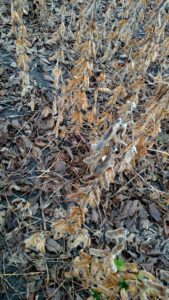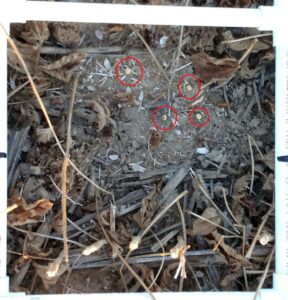Harvest Considerations for Soybeans
By Kayla Weaver
As fall colors pop up across the landscape, producers may feel like their crops have made it across the finish line and the hard part is behind them. However, as soybeans reach maturity and begin to dry for harvest, farmers should be mindful of potential areas of pre-harvest and harvest loss of grain. Laura Lindsey, assistant professor of soybean and small grain production at The Ohio State University offers her top five considerations to make the most of your harvest season.

the ground.
R8 Growth Stage
The R8 growth stage is when the plant is physiologically matured, with 95 percent of the pods at a mature color — either brownish or grey, depending on the variety. When farmers see the pods changing color it’s a good indication that harvest is near, but there are other factors to evaluate before starting up the combine.
Green Stem Syndrome
Sometimes when pods reach the mature color, the stem stays green. When farmers go out to look at maturity, the R8 growth stage is only based on the pods, you have to train your eyes to look past any leaves or green stems plants may have because they can throw off your evaluation.
Harvest Moisture
Soybeans at 13 percent moisture are best for harvest and storage; that’s what farmers should be aiming for. Once the plant is at physiological maturity there usually needs to be an additional 7-10 days for grain to dry down to ideal moisture for harvest. The time frame can vary, too; if it’s hot and dry it will be quicker, or if it’s cool and wet it can take longer.
Pod Re-wetting
If the pods dry down and get rewetted and dry again it weakens the pod structure and can cause pre-harvest pod shatter. That’s when the pod breaks open before harvest and the soybean seed can
spill on the ground. Sometimes farmers don’t harvest timely because of weather, equipment breakdown or prioritizing other fields, and it can contribute to pod shatter.

get too dry, they may shatter during
harvest and leave valuable bushels
behind in the field.
Harvest Loss
Growers also need to watch for potential areas of loss during harvest. You can have pod shatter during harvest when moisture is lower and the grain gets too dry. During harvest trials last year, farmers harvesting at 13 percent moisture saw 1-2 percent harvest loss, which is acceptable and expected. Another farmer harvested at 9 percent moisture and he saw 8 percent harvest loss, which is a significant jump and incentive for farmers to harvest soybeans in a timely manner.
Of course, there are other factors that can influence harvest loss such as combine settings and overall plant health. Adjusting settings appropriately for plant height and moisture conditions
is important.
